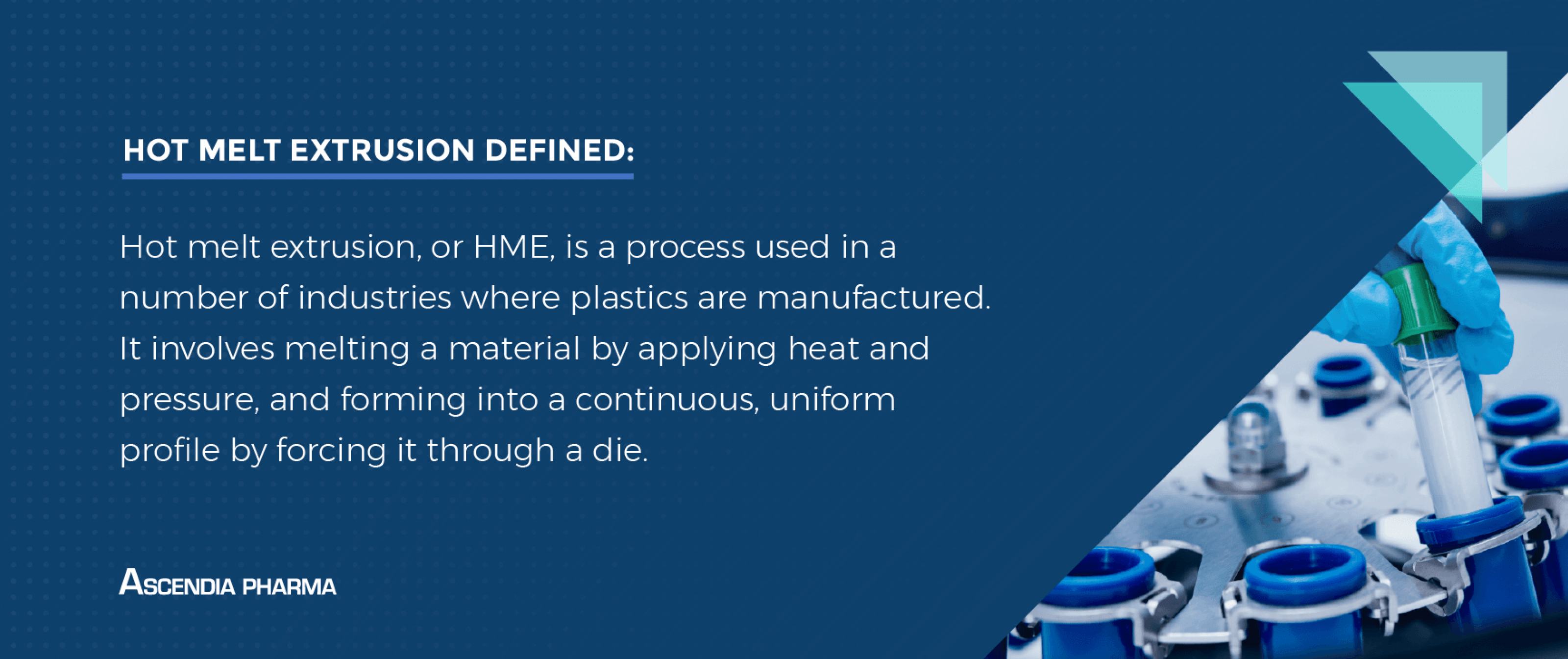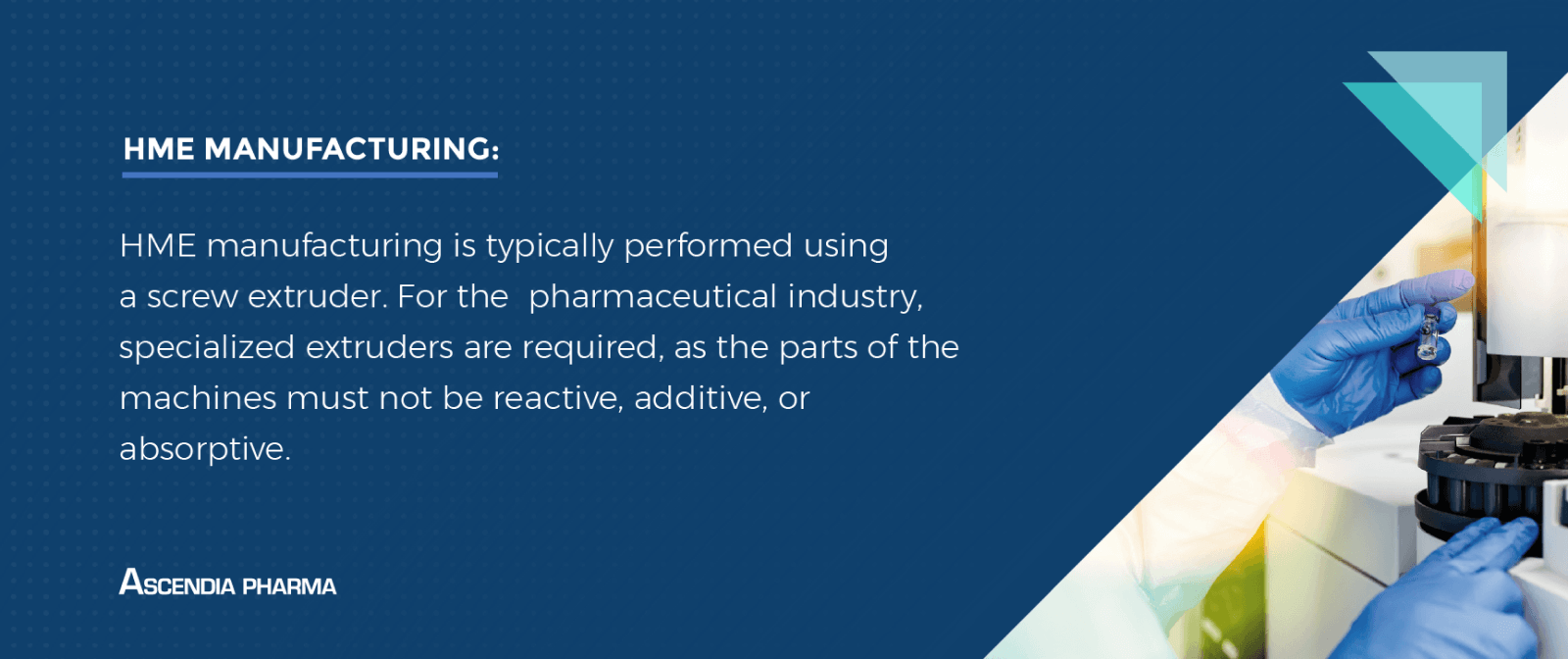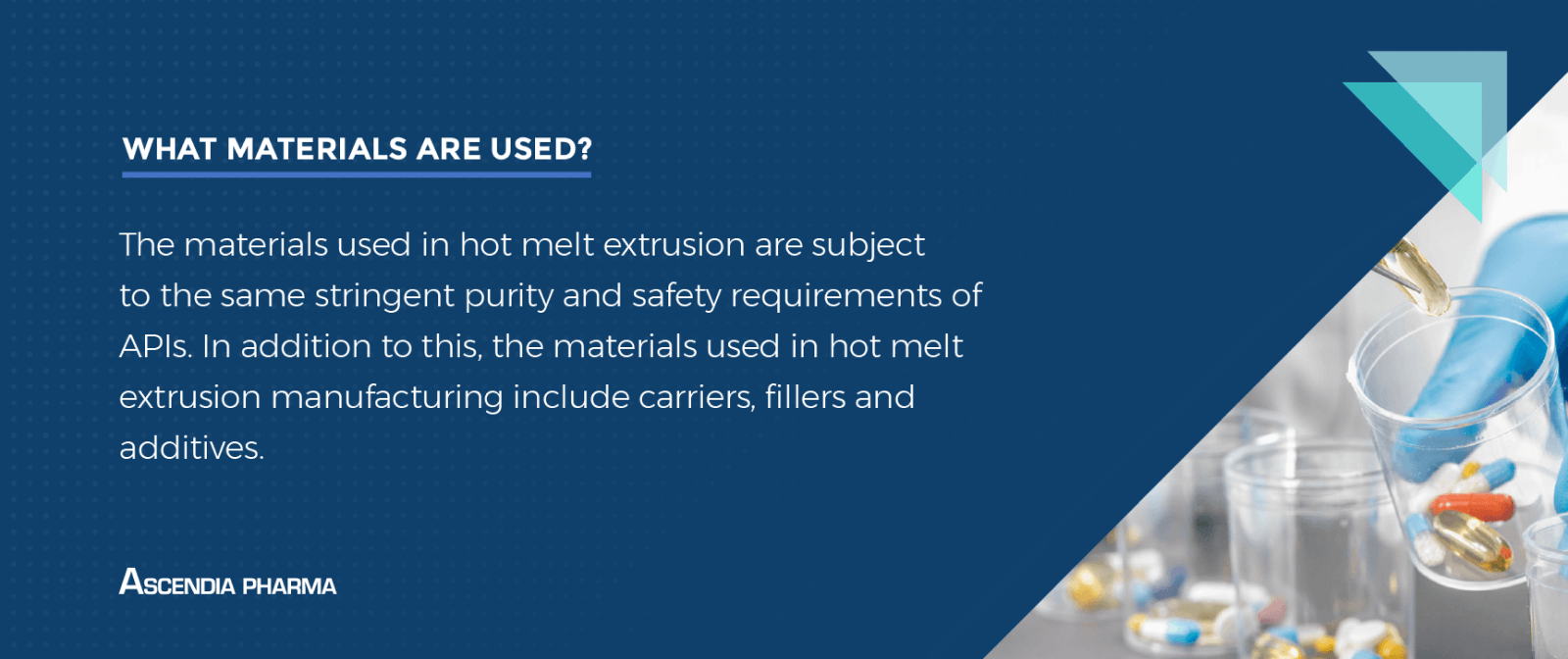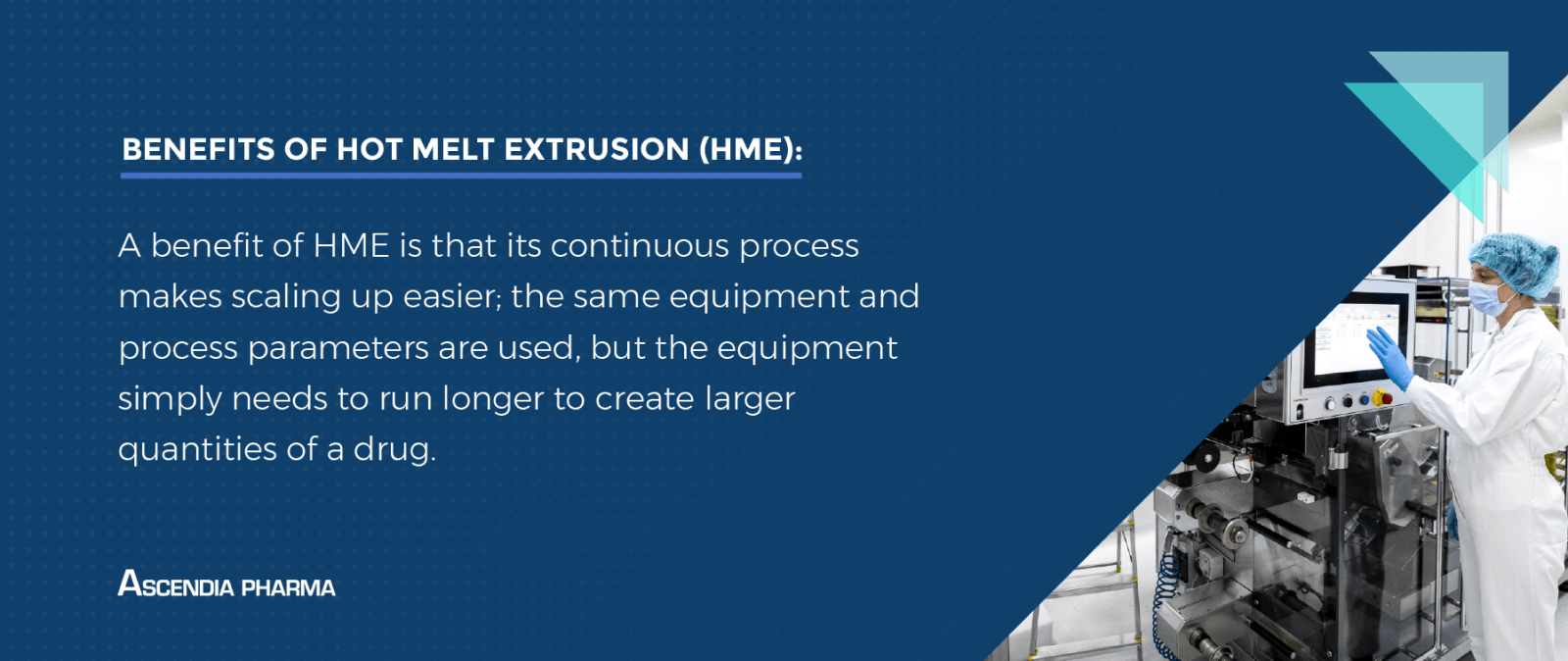Hot Melt Extrusion Formulation & Manufacturing
This article will discuss hot melt extrusion formulation and manufacturing, its advantages, and how it is used to formulate poorly soluble drugs.
What Is Hot Melt Extrusion?
Extrusion is a process used in a number of industries where plastics are manufactured; it involves melting a material by applying heat and pressure, and forming into a continuous, uniform profile by forcing it through a die.
In hot melt extrusion, a molten material is fed into an extruder, and then it is plasticized by shear and heat and forced through a die to form the desired shape. The die forms the cross-sectional profile of the extrudate, which, as mentioned above, can be pellets, granules, tablets, etc.
Even though the method has the word “hot” in its name, HME in the pharmaceutical industry uses polymers that can be processed at relatively low temperatures, which is important given the thermal sensitivity of many active pharmaceutical ingredients (APIs).
HME is a continuous process that can be used to produce drug delivery systems with improved pharmacokinetic and pharmacodynamic profiles. For example, HME can be used to produce immediate-release pellets with a uniform drug release profile or extended-release pellets with zero-order release kinetics.

Applications for Hot Melt Extrusion in the Pharmaceutical Industry
In the pharmaceutical industry, the hot melt method is most commonly used for the following types of applications:
Solid Dispersions
One of the most popular applications for HME is the production of solid dispersions. A solid dispersion is a system in which one or more APIs are dispersed at the molecular level in a matrix of insoluble or barely soluble polymers.
The advantage of using a solid dispersion is to improve the solubility and/or bioavailability of poorly soluble APIs. Solid dispersions prepared by HME have improved API solubility, faster drug release, and more uniform drug release profiles.
Controlled Release
Controlled release systems are designed to release the API over an extended period. The benefit of using a controlled release system is that it allows for a reduction in dosing frequency, which can improve patient compliance. HME can be used to produce various controlled release systems, including pellets, granules, and transdermal patches or films.
Microencapsulated Particles
Microencapsulation is a process in which small particles or droplets are enclosed within a larger shell. Using microencapsulation can improve the stability of thermally labile materials and control the release of poorly soluble drugs. HME can be used to produce microcapsules with a variety of shell materials, including natural and synthetic polymers.
Nanoparticles
Using nanoparticles improves solubility, yields faster drug release, and creates more uniform drug release profiles. Ascendia Pharmaceuticals has developed proprietary nanotechnologies that produce these benefits. HME can be used to produce nanoparticles with a variety of materials including natural and synthetic polymers.
Taste Masking
Finally, hot melt extrusion can be used to mask the naturally bitter taste of many pharmaceutical products. This is accomplished by formulating solid dispersions with a taste-masking polymer that prevents the release of the drug when it comes into contact with saliva.
Advantages of the Hot Melt Extrusion Process
Hot melt extrusion is most commonly used to improve the bioavailability and solubility of an API, or to control its delivery. The advantages of HME over other methods of extrusion include the following:
- The process can be performed at relatively low temperatures, which minimizes thermal degradation of heat-sensitive materials.
- HME is continuous, allowing for a more consistent product quality and improved reproducibility.
- There is no need for post-extrusion drying, which reduces manufacturing time and costs.
- It is a highly automated process with high efficiency.
- The technology is proven and FDA-approved.
- The process can be used to produce a wide range of products with different shapes, sizes, and properties.
In addition, pharmaceutical extrusion technology offers several advantages over other traditional batch processes, such as improved product quality, reduced manufacturing time, better reproducibility, and lower costs.

Wet Extrusion vs. Dry Extrusion
Extrusion can be performed using either a wet or dry process. In wet extrusion, the material to be extruded is mixed with a solvent to condition and soften it, forming a slurry. The slurry is fed into an extruder, where it is plasticized by shear and heat, and then forced through a die to form the desired shape. In dry extrusion, the material to be extruded is mixed with a dry diluent like lactose, but the rest of the process remains the same.
The main advantage of wet extrusion is that it allows for a more uniform distribution of the active ingredient throughout the extrudate, and the extradites have a superior finish after the softening, plasticizing, and ripening process. The benefit of dry extrusion is that it is a simpler process and does not require the use of solvents. Ultimately, dry extrusion is more commonly used in the pharmaceutical industry. Ascendia Pharmaceuticals utilized both wet and dry extrusion in its manufacturing processes.
Hot Melt Extrusion Formulation
When formulating drugs for hot melt extrusion, pharmaceutical companies must consider the following factors:
- Melting point of the drug
- Solubility of the drug in the chosen polymer
- Compatibility of the drug with the chosen polymer
- Thermal stability of the drug
- Viscosity of the melt
When selecting a polymer and additives, pharmaceutical companies must consider what they want from the final product. Does it need to dissolve quickly, or will it be an extended-release product? Is there a bitter taste that must be masked? Is delivery targeted?
The drug-to-polymer ratio can be adjusted to control the release rate of the drug from the final product; a higher drug-to-polymer ratio will result in a faster release rate. The viscosity of the melt can also be controlled by adjusting the molecular weight of the polymer or by adding plasticizers.
Hot Melt Extrusion Manufacturing
HME manufacturing is typically performed using a screw extruder. The screws are designed to generate enough shear force to melt the polymer and mix the drug into it. The screw speed, temperature, and pressure are carefully controlled to produce a consistent product.
Hot Melt Extrusion Pharmaceutical Equipment
Naturally, specialized extruders are required for the pharmaceutical industry, as the parts of the machines must not be reactive, additive, or absorptive. Equipment must also be easy to clean to comply with best practices and government regulations. Ascendia Pharmaceuticals has Class 10,000 (ISO 7) and Class 100 (ISO 5) cleanrooms in its facility for cGMP manufacturing.

Extruders
The type of hot melt extruder machine used for hot melt extrusion depends on the type of drug being manufactured. Despite the different configurations, all screw extruders have a conveying system to transport and mix the materials, a die system, and downstream equipment used to cool, cut, and collect the finished product. Extruders used in HME include:
-
Single Screw Extruders
Single screw extruders are the most commonly used extruders and feature one screw that rotates in a barrel. It generates thousands of pounds of pressure while melting the polymer and mixing the drug. Single screw extruders are usually used for products with a low drug loading and that require an extended-release time.
-
Twin Screw Extruders
Twin screw extruders feature two side-by-side screws that rotate in the same or opposite directions. When the screws are configured to rotate in opposite directions, it produces high shear forces. Twin screw extruders are typically used for products with a high drug loading and products that require a fast dissolution time. While more complex than single screw, twin screw extruders have the advantage of easier feeding, high kneading, improved dispersing capacities, shorter transit time, and a lower likelihood of overheating.
-
Multi-Screw Extruders
Multi-screw extruders are similar to twin screw extruders, but have more than two screws. Multi-screw extruders can be used for products with a high or low drug loading and products that require a fast or extended-release time.
Dies
The die size and shape will determine the final shape and size of the product. For example, if a circular tablet is desired, a round die should be used. If the tablet will be oval-shaped, an oval-shaped die should be used.
Coaters
After extrusion, the pellets can be coated with a film or sugar to improve their stability and dissolution properties. Coating also allows for the controlled release of the drug from the final product.
Materials Used in Hot Melt Extrusion
The materials used in hot melt extrusion are subject to the same stringent purity and safety requirements of APIs. They must also be able to melt in the extruder and solidify as extrudate. In addition to the API, the materials used in hot melt extrusion manufacturing include:
Carriers
A carrier is needed for hot melt extrusion; it could be either a low-melting point wax, like carnauba wax, or a polymer, which is most common.The choice of carrier will depend on the properties of the final product. When a quick-release product is desired, a polymer with a high melt flow rate should be used. If an extended-release product is needed, a polymer with a low melt flow rate, like ethyl cellulose, should be used.
The drug-to-polymer ratio can be adjusted to control the release rate of the drug from the final product. For example, a higher drug-to-polymer ratio will result in a faster release rate.
Fillers
Fillers can be added to hot melt extrusion formulations to improve the physical and chemical properties of the final product. For example, fillers can be added to increase the hardness of the product or to improve the dissolution rate. Common fillers used in hot melt extrusion formulations include:
- Lactose
- Mannitol
- Microcrystalline cellulose
- Silica
- Sorbitol
Additives
Additives are used in hot melt extrusion to improve the processing or physical properties of the product; additives can be used to improve the flow properties of the polymer or to prevent the polymer from sticking to the extruder. Common additives used in hot melt extrusion formulations include:
- Flow aids
- Lubricants
- Plasticizers
- Stabilizers
- Surfactants
- Antioxidants
- UV absorbers

HME Manufacturing Process
No matter the exact equipment and materials used, the hot melt extrusion process varies little. The temperature of each zone in the barrel is set before the extrusion process starts. The feedstock must flow well, which is usually accomplished by making sure the angle of the feed hopper is more than the angle of repose of the feed materials. When this isn't done, the feedstock can form a bridge at the throat of the hopper, which will stop the flow. If this happens, a force-feeding device can be used.
The screw in the barrel turns, which makes the material move. The material also moves thanks to the heat from the screw and from the barrel. The pump is most effective when there is more friction between the material and the barrel, and less friction between the material and the screw. This is because more friction at the barrel makes it easier for the material to move forward, while less friction at the screw means that it is harder for the material to move forward.
The pressure in the compression zone and the metering zone should be high so the extrudate is efficiently produced. The pressure rise in these zones helps ensure a consistent output rate, head pressure, and product quality. To optimize the friction at the barrel surface, it is possible to fine-tune the barrel temperature at the feeding section. If material feed is inconsistent, this may cause a "surge" phenomenon that will lead to cyclical variations in the output rate.
The efficiency of the melting process depends on the properties of the polymer in question, as well as the extruder design. Polymers with low melt viscosities and high thermal conductivities will typically melt more efficiently. If the polymer components do not completely melt, they can block the channel and cause a surge of material around the blockage.
The processing conditions for thermal polymers hinge upon both their chemical stability and physical properties, including their melt viscosity, molecular weight, glass transition temperature, and melting point. Polymers are put under stress from mechanical shear force and high temperatures and pressures; under these conditions, they may break down into smaller pieces, be depolymerized, or degrade. Plasticizers, antioxidants, thermal lubricants, and other additives prevent this.
Common Analytical Techniques for Hot Melt Extrusion Formulation
When it comes to analyzing hot melt extrusion products, there are a number of different methods used; describing each of them in detail would be beyond the scope of this article.
Below, we offer a brief overview of some of the most-used analytical techniques for hot melt extrusion formulation. Ascendia’s team of scientists is experienced in all these processes.
Differential Scanning Calorimetry (DSC)
Differential scanning calorimetry can be used to determine the melting point and glass transition temperature of a polymer. DSC is one of the most commonly used methods of thermal analysis.
Melting point and glass transition temperature are important properties to consider when selecting a polymer for hot melt extrusion. When a fast-dissolving product is required, a polymer with a low melting point should be used. If an extended-release product is necessary, a polymer with a high glass transition temperature would be used instead.
Thermogravimetric Analysis (TGA)
Thermogravimetric analysis is an experimental method used to determine the thermal stability of a polymer by analyzing changes in mass. Thermal stability is important to consider when selecting a polymer for hot melt extrusion. Products that will be exposed to high temperatures during storage should use a polymer with a high thermal stability.
Fourier Transform Infrared Spectroscopy (FTIR)
Fourier Transform Infrared Spectroscopy is used to determine the crystalline content of a polymer, which can affect the physical and chemical properties of the final product.
Size Exclusion Chromatography (SEC)
Size exclusion chromatography is important for determining the molecular weight of a polymer, as the molecular weight of a polymer can affect the stability of the final product during storage and transport.
Rheology
Rheology characterizes the flow and deformation of matter; when it comes to HME analysis, rheology is used to determine the flow properties of a polymer. High viscosity polymers are desirable for extended release products.
Drug Release Testing
Drug release testing determines the release rate of a drug from a formulation. The release rate is important to consider when developing a formulation for hot melt extrusion, and drug-to-polymer ratios can be adjusted to change how quickly the product dissolves.
Powder X-Ray Diffraction (PXRD)
Powder x-ray diffraction is a test used to evaluate the crystallinity of a polymer. When an extended release product is being developed, formulators will often select a polymer with a high degree of crystallinity.
Scaling HME Production
During the early stages of development, smaller batch sizes are extruded because there is typically a limited amount of an API available. As the development process continues, though, laboratory-scale processes must be scaled up.
With other batch processes, scaling up production can present a number of hurdles, leading to costly delays. One of the benefits of HME is that its continuous process makes scaling up easier; the same equipment and process parameters are used, but the equipment simply needs to run longer to create larger quantities of a drug.
If the HME process needs to be transferred from a small extruder to a larger one, it must be characterized to verify that it remains the same even with different equipment; the process must be replicated exactly, with the same melting temperature and viscosity, the same mechanical die strength and geometry, and the same distribution of melt.
There are three parameters used when conducting a scale-up for HME processes: the batch size, the feed rate, and the extruder diameter.

Hot Melt Extrusion for Poorly Soluble Drugs
Hot melt extrusion can be used to improve the solubility of poorly soluble drugs by increasing the surface area. Increasing the surface area of the drug increases the amount of drug that is available for dissolution, which is achieved using Ascendia’s nanotechnologies.
HME can also be used to improve the solubility of poorly soluble drugs by creating a more porous product, as a more porous product has a larger surface area and is more likely to dissolve in the body.
To create a more soluble product, it is important to use the right ratio of drug to polymer. A higher drug-to-polymer ratio results in a more soluble product. It’s also important to choose the right type of polymer, as this can play a significant role in the solubility of the final product.
Ascendia Leads the Way in Hot Melt Extrusion Manufacturing
At Ascendia Pharmaceuticals, we specialize in formulating and manufacturing poorly water soluble drugs; one way we accomplish this is through hot melt extrusion. We take an innovative approach to applying this technique, enhancing bioavailability, solubility, and delivery with new polymers and state-of-the-art technologies.

